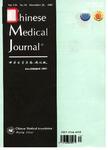Atrial Septal Defect, Neuromuscular Junction and Skeletal Abnormalities in Spinal Muscular Atrophy Type Ⅲ
Atrial Septal Defect, Neuromuscular Junction and Skeletal Abnormalities in Spinal Muscular Atrophy Type Ⅲ作者机构:Department of Neurology and Institute of Neurology Ruijin Hospital Affiliated to Shanghai JiaoTong University School of Medicine Shanghai 200025 China
出 版 物:《Chinese Medical Journal》 (中华医学杂志(英文版))
年 卷 期:2017年第130卷第19期
页 面:2382-2383页
核心收录:
学科分类:090603[农学-临床兽医学] 0710[理学-生物学] 1002[医学-临床医学] 07[理学] 09[农学] 0906[农学-兽医学] 071002[理学-动物学]
基 金:国家自然科学基金
主 题:Atrial Septal Defect Multi-organ Diseases Neuromuscular Junction Skeletal Abnormalities Spinal Muscular Atrophy Type Ⅲ
摘 要:Spinal muscular atrophy (SMA) is a genetic disorder which is clinically characterized by progressive muscle weakness and atrophy and is associated with the degeneration of spinal and lowers bulbar motor neurons. SMAis the most common genetic cause of infant mortality, and seems to be present in general populations. The clinical spectrum of SMA ranges from early infant death to normal adult life with only mild weakness. Approximately 81.2–95.0% of cases of SMA resulted from homozygous deletion of survival of motor neuron 1 (SMN1) and 5.0% were compound heterozygous patients.[1] SMA might manifest not only the dysfunction of pure motor neurons but also abnormalities in neuromuscular junction (NMJ), osteoporotic bone formation, cardiac abnormalities, and vascular defects.[2] These phenomena have been described in severe SMA (Type I, II) patients and in mouse models while data from SMA Type III individuals are not available. Patients with SMA Type III demonstrate progressive proximal weakness affecting the legs more severely than the arms, and might ultimately end up in the wheelchair. Herein, we report one patient with SMA Type III manifesting an atrial septal defect (ASD), NMJ defect, short stature, and thick toes.



